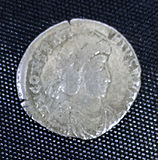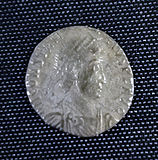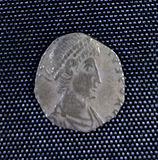- Methods of coin debasement
-
This article is about grassroots methods of coin debasement. For coin debasement generally, see debasement.
Coin debasement is the act of decreasing the amount of precious metal in a coin, while continuing to circulate it at face value. This was frequently done by governments in order to inflate the amount of currency in circulation; typically, some of the precious metal was replaced by a cheaper metal when the coin was minted. But when done by an individual, precious metal was physically removed from the coin; which could then be passed on at the original face value, leaving the debaser with a profit. Coin debasement was effected by several methods, including clipping (shaving metal from the coin's circumference) and sweating (shaking the coins in a bag and collecting the dust worn off).
Until the mid 20th century, coins were often made of silver or gold, which were quite soft and prone to wear. This meant coins naturally got lighter (and thus less valuable) as they aged, so coins that had lost a small amount of bullion would go unnoticed. Modern coins are made of hard, cheap metals such as steel, copper or a copper-nickel alloy, reducing wear and making it difficult and unprofitable to debase them.
Clipping is the act of shaving off a small portion of a precious metal coin for profit. Over time the precious metal clippings could be saved up and melted into bullion or used to make new coins.[1][2]
Coin clipping was usually considered by the law to be of a similar magnitude to counterfeiting, and was occasionally punished by death[1][3][4], a fate which befell Thomas Rogers and Anne Rogers.
Coin clipping is why many coins have the rim of the coin marked with stripes (milling or reeding), text (engraving) or some other pattern that would be destroyed if the coin were clipped, a process attributed to Isaac Newton,[1] after being appointed Master of the Mint (charge he held from 1699 to his death in 1727). Although the metal used in most modern coins is not intrinsically valuable, modern milling can be a deterrent to counterfeiting, an aid to the blind to distinguish different denominations, or purely decorative.
Comparison of unclipped and clipped Siliqua from the Hoxne Hoard An unclipped siliquaPartially clipped siliquaA clipped siliquaIn the process of sweating, coins were placed in a bag and shaken. The bits of metal worn off of the coins were recovered from the bottom of the bag.[5] Sweating tended to wear the coin in a more natural way than clipping, and so was harder to detect.[6]
If the coin was large, a hole could be punched out of the middle, and the face of the coin hammered to close up the hole.[7] Or the coin could be sawed in half, and a plug of metal extracted from the interior. After filling the hole with a cheaper metal, the two halves would be welded back together again.[8]
References
- ^ a b c Cooper, George (2008). The origin of financial crises. Harriman House. p. 46. http://books.google.com/books?id=4XWH_SqAkHMC&pg=PA46#v=onepage&q&f=false.
- ^ Redish, Angela (2000). Bimetallism: an economic and historical analysis. Cambridge University Press. p. 54. ISBN 0521570913. http://books.google.com/books?id=w6cePxd3--UC&pg=PA54#v=onepage&q&f=false.
- ^ See for example the English Treason Act 1415.
- ^ Allen 2009, p. 71.
- ^ Sherwood 1893, p. 70.
- ^ Allen 2009, p. 72.
- ^ Sherwood 1893, p. 70–71.
- ^ Sherwood 1893, p. 71.
- Allen, Larry (2009). The encyclopedia of money (2 ed.). ABC-CLIO. ISBN 9781598842517. http://books.google.com/books?id=X4kgDkYxGrcC.
- Sherwood, Sidney (1893). The history and theory of money. Lippincott. http://books.google.com/books?id=Q0USAQAAMAAJ.
External links
Categories:- Coins
- Commercial crimes
Wikimedia Foundation. 2010.



